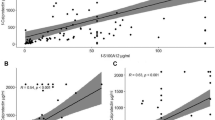Abstract
The glycoprotein lactoferrin is found in many body fluids but also in the granules of neutrophilic granulocytes. Fecal lactoferrin levels increase quickly with the influx of leukocytes into the intestinal lumen during inflammation. This biomarker has recently been shown to be a sensitive and specific marker of disease activity in chronic inflammatory bowel disease. Our aim was the determination of fecal lactoferrin as a marker of intestinal inflammation and therapeutic response following infliximab therapy in pediatric patients with Crohn's disease (CD). A total of five patients (ages 10-15 years) with severe Crohn's disease as defined by the Pediatric Crohn's Disease Activity Index (PCDAI) was enrolled in the study. The fecal lactoferrin levels were determined before and after therapy with infliximab by a quantitative lactoferrin ELISA (IBD-SCAN; TechLab, Inc.). Of the five patients on infliximab therapy, three received a single infusion and the remaining two underwent a regime with three maintenance infusions. All five patients responded to infliximab clinically after the first infusion, and in all patients, fecal lactoferrin levels significantly and rapidly decreased from elevated to near baseline in parallel to clinical assessment and the PCDAI. The reduction in fecal lactoferrin at days 7-10 was 93.43 ± 4.49%, in comparison with the level before infliximab therapy, and correlated with a mean decrease in the PCDAI from 48.50 to 14.0. For the patients followed during multiple infusions, one remained with mild disease and the other reached remission (subjective and PCDAI). Fecal lactoferrin is a sensitive and specific biomarker representing intestinal inflammation and response to therapy in pediatric patients with Crohn's disease. It may be a helpful noninvasive diagnostic tool for monitoring therapeutic efficiency in pediatric IBD patients. Future studies are needed to further establish the relationship between endoscopic changes and the level of fecal lactoferrin as well as the possible role of lactoferrin as being an early and preclinical indicator of relapse.
Similar content being viewed by others
REFERENCES
Van Dullemen HM, van Deventer SJ, Hommes DW, Bijl HA, Jansen J, Tytgat GN, Woody J: Treatment of Crohn's disease with anti-tumor necrosis factor chimeric monoclonal antibody (cA2). Gastroenterol-ogy 109:129–135, 1995
Hanauer SB, Feagan BG, Lichtenstein GR, Mayer LF, Schreiber S, Colombel JF, Rachmilewitz D, Wolf DC, Olson A, Bao W, Rutgeerts P, ACCENT I Study Group: Maintenance infliximab for Crohn's disease: The ACCENT I randomised trial. Lancet 359:1541–1549, 2002
Hyams JS, Markowitz J, Wyllie R: Use of infliximab in the treatment of Crohn's disease in children and adolescents. J Pediatr 137(1):92–96, 2000
Baldassano R, Braegger CP, Escher JC, DeWoody K, Hendricks DF, Keenan GF, Winter H: Infliximab (REMICADE) therapy in the treatment of pediatric Crohn's disease. Am J Gastroenterol 98:833–838, 2003
Present DH, Rutgeerts P, Targan S, Hanauer SB, Mayer L, van Hogezand RA, Podolsky DK, Sands BE, Braakman T, DeWoody KL, Schaible TF, van Deventer SJ: Infliximab for the treatment of fistulas in patients with Crohn's disease. N Engl J Med 340:1398–1405, 1999
D'haens G, Van Deventer S, Van Hogezand R, Chalmers D, Kothe C, Baert F, Braakman T, Schaible T, Geboes K, Rutgeerts P: Endo-scopic and histological healing with infliximab anti-tumor necrosis factor antibodies in Crohn's disease: A European multicenter trial. Gastroenterology 116:1029–1034, 1999
Kane SV, Sandborn WJ, Rufo PA, Zholudev A, Boone J, Lyerly D, Camilleri M, Hanauer SB: Fecal lactoferrin is a sensitive and specific marker in the diagnosis of chronic inflammatory bowel disease. Am J Gastroenterol 98:1309–1314, 2003
Kayazawa M, Saitoh O, Kojima K, Nakawaga K, Tanaka S, Tabata K, Matsuse R, Uchida K, Hoshimoto M, Hirata I, Katsu K: Lactoferrin in whole gut lavage as a marker for disease activity in inflammatory bowel disease. Am J Gastroenterol 97:360–369, 2002
Buderus S, Lentze MJ, Boone J, Lyerly D: Fecal lactoferrin: Sen-sitive marker for monitoring pediatric patients with inflammatory bowel disease. Gastro 122:A-219, 2002
Hyams JS, Ferry GD, Mandel FS, Gryboski JD, Kibort PM, Kirschner BS, Griffiths AM, Katz AJ, Grand RJ, Boyle JT, Michener WM, Levy JS, Lesser ML: Development and validation of a pedi-atric Crohn's disease activity index. J Pediatr Gastroenterol Nutr 12:439–447, 1991
Otley A, Loonen H, Parekh N, Corey M, Sherman PM, Griffith AM: Assessing activity of pediatric Crohn's disease: Which index to use? Gastroenterology 116:527–531, 1999
Walker TR, Sandborn WJ, Boone J, Lyerly D, Rufo P: Fecal lacto-ferrin measurements are useful in the interval assessment of pa-tients with active and inactive IBD. Am J Gastroenterol 98:S 246:742, 2003
Author information
Authors and Affiliations
Rights and permissions
About this article
Cite this article
Buderus, S., Boone, J., Lyerly, D. et al. Fecal Lactoferrin: A New Parameter to Monitor Infliximab Therapy. Dig Dis Sci 49, 1036–1039 (2004). https://doi.org/10.1023/B:DDAS.0000034568.69407.47
Issue Date:
DOI: https://doi.org/10.1023/B:DDAS.0000034568.69407.47



